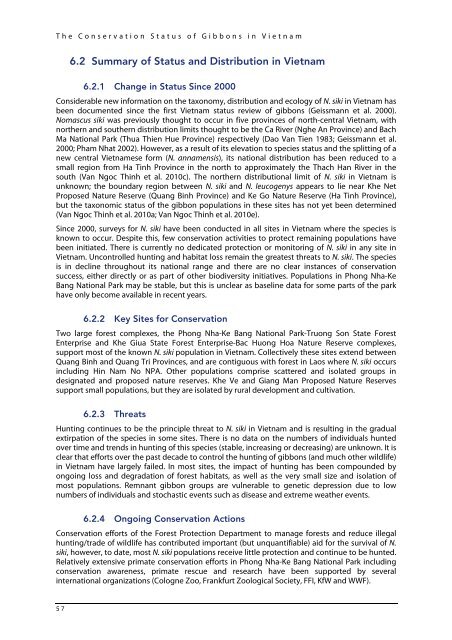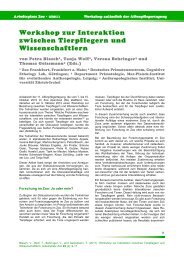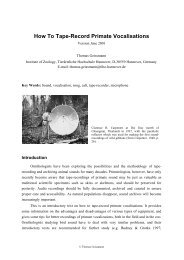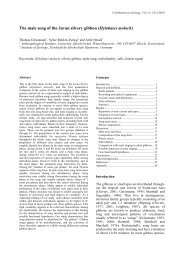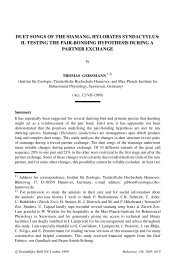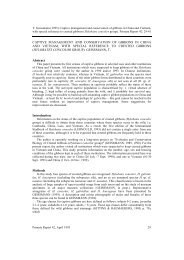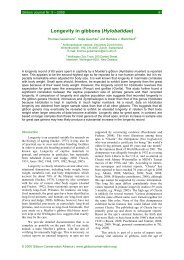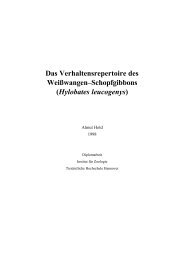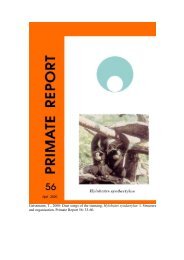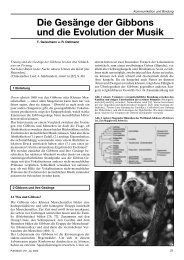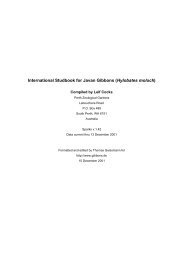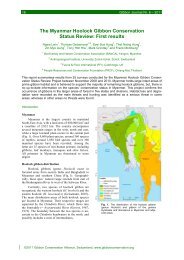Nomascus siki6 Southern White-cheeked <strong>Gibbon</strong>Nomascus siki (Delacour, 1951)Other English names: southern white-cheeked crested gibbon, siki gibbon<strong>Vietnam</strong>ese names: vượn má trắng nam, vượn đen má trắng, vượn bạc má, vượn hót, vượn đensiki, vượn đen má hungIUCN Red List Category and Criteria: Endangered A2cd (ver. 3.1)2007 <strong>Vietnam</strong> Red Data Book Category and Criteria: Endangered A1cd C2aLegislative status <strong>in</strong> <strong>Vietnam</strong>: Decree 32/2006 ND-CP: 1B (considered a sub-species <strong>of</strong> N.leucogenys)CITES: Appendix I6.1 Global <strong>Status</strong> and DistributionNomascus siki occurs with<strong>in</strong> a small region <strong>of</strong> central <strong>Vietnam</strong> and Laos, where its range is limitedby the Mekong River <strong>in</strong> the west and <strong>Vietnam</strong>’s coastal agricultural areas <strong>in</strong> the east (Geissmann etal. 2000). <strong>The</strong> taxonomic status <strong>of</strong> N. siki has received <strong>in</strong>consistent treatment by various authorsand this warrants caution <strong>in</strong> the assessment <strong>of</strong> records for this species. Nomascus siki wasorig<strong>in</strong>ally considered a subspecies <strong>of</strong> N. concolor (Groves 1972; Dao Van Tien 1983), was laterreclassified as a subspecies <strong>of</strong> N. gabriellae (Groves & Wang Y<strong>in</strong>gxiang 1990) and then <strong>of</strong> N.leucogenys (Geissmann 1993, 1994, 1995; Geissmann et al. 2000; Roos 2004; Roos et al. 2007) andsubsequently elevated to species status (Zhang 1997; Groves 2001; Mootnick 2006; Geissmann2007b; Van Ngoc Th<strong>in</strong>h et al. 2010b; Van Ngoc Th<strong>in</strong>h et al. 2010c; Van Ngoc Th<strong>in</strong>h et al. 2010e;Mootnick & Fan Pengfei 2011; Van Ngoc Th<strong>in</strong>h et al. 2011). Based on genetic and vocal datathroughout the range <strong>of</strong> Nomascus taxa, the distribution <strong>of</strong> N. siki has been revised, with aconsiderable reduction <strong>in</strong> its range (Van Ngoc Th<strong>in</strong>h et al. 2010e). <strong>The</strong> species may now warrantlist<strong>in</strong>g as ‘Critically Endangered’ and a reassessment <strong>of</strong> its IUCN Red List status is required. <strong>The</strong>re isno global population estimate for N. siki populations <strong>in</strong> Laos although it is thought to be largerthan <strong>in</strong> <strong>Vietnam</strong> (Geissmann et al. 2000; Duckworth 2008). All populations are threatened due tohunt<strong>in</strong>g and habitat degradation.In Laos, N. siki is thought to occur from Nam Kad<strong>in</strong>g National Protected Area (NPA), south <strong>of</strong> theKad<strong>in</strong>g River, <strong>in</strong> the north to at least Phou Xang He NPA <strong>in</strong> the south, and possibly further south toDong Phou Vieng NPA (Van Ngoc Th<strong>in</strong>h et al. 2010e). No population estimates exist for thespecies <strong>in</strong> Laos, however there are several likely significant populations <strong>in</strong> areas under activemanagement, <strong>in</strong>clud<strong>in</strong>g those <strong>in</strong> Nam Kad<strong>in</strong>g NPA and Nakai-Nam <strong>The</strong>un NPA (athough speciesassignation is not yet clear for this site), and others <strong>in</strong> areas with good natural protection such asPhou H<strong>in</strong> Boun NPA and H<strong>in</strong> Nam No NPA (Duckworth 2008; Hallam pers. comm.).In <strong>Vietnam</strong>, N. siki occurs <strong>in</strong> parts <strong>of</strong> Ha T<strong>in</strong>h, Quang B<strong>in</strong>h and Quang Tri Prov<strong>in</strong>ces. Populationshave been documented <strong>in</strong> six sites: two protected areas (Phong Nha-Ke Bang National Park, BacHuong Hoa Nature Reserve), two proposed nature reserves (Khe Ve, Giang Man) and two stateforest enterprises (Truong Son, Khe Giua).56
<strong>The</strong> <strong>Conservation</strong> <strong>Status</strong> <strong>of</strong> <strong><strong>Gibbon</strong>s</strong> <strong>in</strong> <strong>Vietnam</strong>6.2 Summary <strong>of</strong> <strong>Status</strong> and Distribution <strong>in</strong> <strong>Vietnam</strong>6.2.1 Change <strong>in</strong> <strong>Status</strong> S<strong>in</strong>ce 2000Considerable new <strong>in</strong>formation on the taxonomy, distribution and ecology <strong>of</strong> N. siki <strong>in</strong> <strong>Vietnam</strong> hasbeen documented s<strong>in</strong>ce the first <strong>Vietnam</strong> status review <strong>of</strong> gibbons (Geissmann et al. 2000).Nomascus siki was previously thought to occur <strong>in</strong> five prov<strong>in</strong>ces <strong>of</strong> north-central <strong>Vietnam</strong>, withnorthern and southern distribution limits thought to be the Ca River (Nghe An Prov<strong>in</strong>ce) and BachMa National Park (Thua Thien Hue Prov<strong>in</strong>ce) respectively (Dao Van Tien 1983; Geissmann et al.2000; Pham Nhat 2002). However, as a result <strong>of</strong> its elevation to species status and the splitt<strong>in</strong>g <strong>of</strong> anew central <strong>Vietnam</strong>ese form (N. annamensis), its national distribution has been reduced to asmall region from Ha T<strong>in</strong>h Prov<strong>in</strong>ce <strong>in</strong> the north to approximately the Thach Han River <strong>in</strong> thesouth (Van Ngoc Th<strong>in</strong>h et al. 2010c). <strong>The</strong> northern distributional limit <strong>of</strong> N. siki <strong>in</strong> <strong>Vietnam</strong> isunknown; the boundary region between N. siki and N. leucogenys appears to lie near Khe NetProposed Nature Reserve (Quang B<strong>in</strong>h Prov<strong>in</strong>ce) and Ke Go Nature Reserve (Ha T<strong>in</strong>h Prov<strong>in</strong>ce),but the taxonomic status <strong>of</strong> the gibbon populations <strong>in</strong> these sites has not yet been determ<strong>in</strong>ed(Van Ngoc Th<strong>in</strong>h et al. 2010a; Van Ngoc Th<strong>in</strong>h et al. 2010e).S<strong>in</strong>ce 2000, surveys for N. siki have been conducted <strong>in</strong> all sites <strong>in</strong> <strong>Vietnam</strong> where the species isknown to occur. Despite this, few conservation activities to protect rema<strong>in</strong><strong>in</strong>g populations havebeen <strong>in</strong>itiated. <strong>The</strong>re is currently no dedicated protection or monitor<strong>in</strong>g <strong>of</strong> N. siki <strong>in</strong> any site <strong>in</strong><strong>Vietnam</strong>. Uncontrolled hunt<strong>in</strong>g and habitat loss rema<strong>in</strong> the greatest threats to N. siki. <strong>The</strong> speciesis <strong>in</strong> decl<strong>in</strong>e throughout its national range and there are no clear <strong>in</strong>stances <strong>of</strong> conservationsuccess, either directly or as part <strong>of</strong> other biodiversity <strong>in</strong>itiatives. Populations <strong>in</strong> Phong Nha-KeBang National Park may be stable, but this is unclear as basel<strong>in</strong>e data for some parts <strong>of</strong> the parkhave only become available <strong>in</strong> recent years.6.2.2 Key Sites for <strong>Conservation</strong>Two large forest complexes, the Phong Nha-Ke Bang National Park-Truong Son State ForestEnterprise and Khe Giua State Forest Enterprise-Bac Huong Hoa Nature Reserve complexes,support most <strong>of</strong> the known N. siki population <strong>in</strong> <strong>Vietnam</strong>. Collectively these sites extend betweenQuang B<strong>in</strong>h and Quang Tri Prov<strong>in</strong>ces, and are contiguous with forest <strong>in</strong> Laos where N. siki occurs<strong>in</strong>clud<strong>in</strong>g H<strong>in</strong> Nam No NPA. Other populations comprise scattered and isolated groups <strong>in</strong>designated and proposed nature reserves. Khe Ve and Giang Man Proposed Nature Reservessupport small populations, but they are isolated by rural development and cultivation.6.2.3 ThreatsHunt<strong>in</strong>g cont<strong>in</strong>ues to be the pr<strong>in</strong>ciple threat to N. siki <strong>in</strong> <strong>Vietnam</strong> and is result<strong>in</strong>g <strong>in</strong> the gradualextirpation <strong>of</strong> the species <strong>in</strong> some sites. <strong>The</strong>re is no data on the numbers <strong>of</strong> <strong>in</strong>dividuals huntedover time and trends <strong>in</strong> hunt<strong>in</strong>g <strong>of</strong> this species (stable, <strong>in</strong>creas<strong>in</strong>g or decreas<strong>in</strong>g) are unknown. It isclear that efforts over the past decade to control the hunt<strong>in</strong>g <strong>of</strong> gibbons (and much other wildlife)<strong>in</strong> <strong>Vietnam</strong> have largely failed. In most sites, the impact <strong>of</strong> hunt<strong>in</strong>g has been compounded byongo<strong>in</strong>g loss and degradation <strong>of</strong> forest habitats, as well as the very small size and isolation <strong>of</strong>most populations. Remnant gibbon groups are vulnerable to genetic depression due to lownumbers <strong>of</strong> <strong>in</strong>dividuals and stochastic events such as disease and extreme weather events.6.2.4 Ongo<strong>in</strong>g <strong>Conservation</strong> Actions<strong>Conservation</strong> efforts <strong>of</strong> the Forest Protection Department to manage forests and reduce illegalhunt<strong>in</strong>g/trade <strong>of</strong> wildlife has contributed important (but unquantifiable) aid for the survival <strong>of</strong> N.siki, however, to date, most N. siki populations receive little protection and cont<strong>in</strong>ue to be hunted.Relatively extensive primate conservation efforts <strong>in</strong> Phong Nha-Ke Bang National Park <strong>in</strong>clud<strong>in</strong>gconservation awareness, primate rescue and research have been supported by several<strong>in</strong>ternational organizations (Cologne Zoo, Frankfurt Zoological Society, FFI, KfW and WWF).57
- Page 2:
The Conservation Status of Gibbons
- Page 7:
The Conservation Status of Gibbons
- Page 10 and 11:
A site is defined in this report as
- Page 12 and 13:
Abbreviations and Acronymsa.s.l. ab
- Page 14 and 15:
carried out in 2000 and 2001. At Ho
- Page 16 and 17:
ConclusionsWhile gibbons are afford
- Page 18 and 19:
IntroductionChapter 1IntroductionFe
- Page 20 and 21:
Introductionexperienced conservatio
- Page 22 and 23: The Conservation Status of Gibbons
- Page 24 and 25: The Conservation Status of Gibbons
- Page 26 and 27: The Conservation Status of Gibbons
- Page 28 and 29: The Conservation Status of Gibbons
- Page 30 and 31: The Conservation Status of Gibbons
- Page 32 and 33: The Conservation Status of Gibbons
- Page 34 and 35: The Conservation Status of Gibbons
- Page 36 and 37: Nomascus nasutusChapter 3Eastern bl
- Page 38 and 39: Nomascus nasutus3 Eastern Black Gib
- Page 40 and 41: Nomascus nasutusrecorded on an ad h
- Page 42 and 43: Nomascus nasutusand field surveys,
- Page 44 and 45: Nomascus concolorChapter 4Western b
- Page 46 and 47: Nomascus concolor4 Western Black Gi
- Page 48 and 49: Nomascus concolorwill provide incre
- Page 50 and 51: Nomascus concolorthose in neighbour
- Page 52 and 53: Nomascus concolorDat & Le Minh Phon
- Page 54 and 55: Nomascus leucogenysChapter 5Norther
- Page 56 and 57: Nomascus leucogenys5 Northern White
- Page 58 and 59: Nomascus leucogenys5.3 Nomascus leu
- Page 60 and 61: Nomascus leucogenysNguyen Manh Ha e
- Page 62 and 63: Nomascus leucogenysThe reserve mana
- Page 64 and 65: Nomascus leucogenys5.3.10 Pu Mat Na
- Page 66 and 67: Nomascus leucogenysStatusA 13 day s
- Page 68 and 69: Nomascus leucogenysDuong Anh Tuan 2
- Page 70 and 71: Nomascus sikiChapter 6Southern whit
- Page 74 and 75: Nomascus siki6.2.5 Priority Conserv
- Page 76 and 77: Nomascus sikithese vagaries, the pa
- Page 78 and 79: Nomascus sikifield records (Le Manh
- Page 80 and 81: Nomascus annamensisChapter 7Norther
- Page 82 and 83: Nomascus annamensis7 Northern Yello
- Page 84 and 85: Nomascus annamensisStatusThis site
- Page 86 and 87: Nomascus annamensisThreats and Cons
- Page 88 and 89: Nomascus annamensisDate of most rec
- Page 90 and 91: Nomascus annamensisThreats and Cons
- Page 92 and 93: Nomascus annamensisgroups) and 148
- Page 94 and 95: Nomascus annamensisThreats and Cons
- Page 96 and 97: Nomascus gabriellaeChapter 8Souther
- Page 98 and 99: Nomascus gabriellae8 Southern Yello
- Page 100 and 101: Nomascus gabriellae8.2.4 Ongoing Co
- Page 102 and 103: Nomascus gabriellae8.3.4 Chu Yang S
- Page 104 and 105: Nomascus gabriellaeThreats and Cons
- Page 106 and 107: Nomascus gabriellaeDate of most rec
- Page 108 and 109: Nomascus gabriellaepark-wide census
- Page 110 and 111: Nomascus gabriellaeStatusThis reser
- Page 112 and 113: Classification & Distribution of Cr
- Page 114 and 115: Classification & Distribution of Cr
- Page 116 and 117: Classification & Distribution of Cr
- Page 118 and 119: Classification & Distribution of Cr
- Page 120 and 121: Classification & Distribution of Cr
- Page 122 and 123:
Classification & Distribution of Cr
- Page 124 and 125:
Classification & Distribution of Cr
- Page 126 and 127:
Ecology & Behaviour of Crested Gibb
- Page 128 and 129:
Ecology & Behaviour of Crested Gibb
- Page 130 and 131:
Ecology & Behaviour of Crested Gibb
- Page 132 and 133:
Ecology & Behaviour of Crested Gibb
- Page 134 and 135:
References11 ReferencesAbramov, A.
- Page 136 and 137:
ReferencesDang Ngoc Can, Pham Duc T
- Page 138 and 139:
ReferencesGeissmann, T., Nguyen Man
- Page 140 and 141:
ReferencesLa Quang Trung, and Trinh
- Page 142 and 143:
ReferencesLuong Van Hao, and Le Van
- Page 144 and 145:
ReferencesNguyen Quang Hoa Anh, Tha
- Page 146 and 147:
ReferencesSrikosamatara, S., and S.
- Page 148 and 149:
AnnexesAnnex 1. Summary of Gibbon R
- Page 150 and 151:
AnnexesSiteProvinceArea(ha)Minimum
- Page 152 and 153:
Annexesd) number of locations or su
- Page 154:
Annexesc) area, extent or quality o


